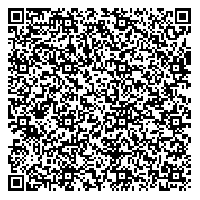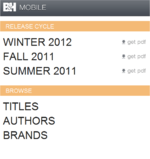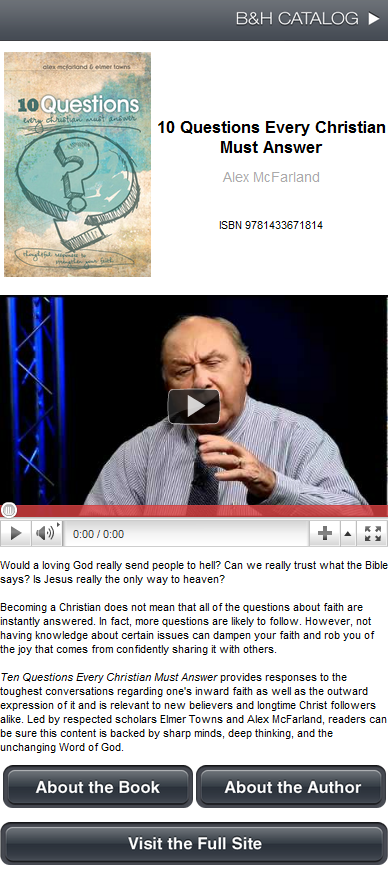Real world usage of QR Codes
I don't remeber when I first heard about QR codes. It was a few years ago, that's to be sure. I vividly recall the first time I heard about Microsoft Tag codes, due to it being used with Viva Pinata, and I know I had heard about QRs before then... but I digress. The key is, QR codes have been around a long time (1994, if Wikipedia is to be believed) and finally consumer devices and awareness are getting to a point where they can be effective.
As a part of B&H Publishing Group, we've been using QR codes for a few years, usually pointing readers to videos about our books or custom web pages for specific titles. For the past year or so we had been in "experiment" mode with QR codes, trying to discover how to use properly and not just slap them on to everything with no real strategy. Like many things that gain sudden awareness, there is the danger in marketing to just go with the flow and try to be "cool" instead of truly knowing the technology.
Part of knowing the technology is not just creating new things, but using the medium. It's impossible to know what kind of iOS app is right for your audience if you don't own an iPad and use it on a daily basis. It's impossible to begin designing a website if you never visit a competitor's site. Likewise, it's foolish to start slapping aroudn QR codes without inherantly knowing it's strengths and proper usage.

First, let's clear up one major misconception: QR codes are not an easy way to get attention. It's not as simple as place a QR code somewhere and magic happens. Getting a real live person in the real world to scan your QR code takes commitment from the user. They have to pull their phone out of their pocket. They have to turn it on and then open their favorite QR scanner app. Their camera has to focus, be able to properly scan the QR code, and, if you are sending them to a website, they have to have a good enough data connection to load your page. There are a lot of steps to get from code to something on their screen.
Here's the danger of QR codes: it only takes a few lame experiences with the QR-directed content to get a person to never bother with scanning a QR code again. And no matter how cool your QR-directed content is, someone else's is lame.
There are two main uses for QR codes: displaying messages and directing the user's web browser. Sending messages is an incredibly under used technique that can have a lot of real-world applications. Specifically, if you have a custom QR code reader built, you can unlock content for the user by required the physical scan of a code. Or, if you're creating some kind of physical product with hidden messages, you can hold just over 4,000 characters in a QR code. At this point in this blog post, we have yet to hit 3,000 characters.
 The second, more common usage is directing traffic for the web browser. Most QR scanners will notice that the code is a web address and direct the device's browser to the webpage. Since the vast majority of consumer oriented QR readers are actually apps on mobile phones, this means that the landing page for the QR code should be mobile optimized.
The second, more common usage is directing traffic for the web browser. Most QR scanners will notice that the code is a web address and direct the device's browser to the webpage. Since the vast majority of consumer oriented QR readers are actually apps on mobile phones, this means that the landing page for the QR code should be mobile optimized.
At B&H, we recently launched a fully QR-code and mobile friendly site. Every book we publish has a mobile page automatically generated at http://www.bhpublishinggroup.com/qr
From this mobile site, individual product pages can be navigated to through either the upcoing release cycles for our books, or by browsing our entire catalog of active products. Usually, however, when we create a QR code we are intending to take the user to a specific product page so they can get more information about the book or see any additional content that can't be put on a print advertisement, like a video. In this case, we take them to a page where the user can grab all the pertinant information and play any associated videos in a format specifically designed to be viewed on a wide variety of mobile devices.

One of the products I am most excited about coming from us this year is the Life Essentials Study Bible with Gene Getz. We had to keep this one quite for far too long, but now we can talk about it: the Life Essentials Study Bible will have 1,500 QR codes printed on the pages of the Bible alongside each of Gene Getz's Principles to Live By. Each principle comes with a teaching segment from Getz that was filmed over the past several years. As you're reading the Bible you can scan the QR code and be taken to the corresponding teaching.
The combined videos are over 250 hours of teaching from Gene Getz. This is what makes QR codes so exciting to me. When used in the right ways, QR codes can serve to enhance content in ways never dreamed of before. Thinking about a physical Bible that plays videos for you as you are reading the text was, up until now, science fiction. Projects like this are taking today's technologies and utilizing them to deepen our learning experience. We are able to take the teachings of an incredible man of God like Gene Getz and share them with the world through printing a crazy looking square on the page.
I'm studying to be a futurist, yet being a part of a project like this is so humbling and mind-blowing.
There are so many exciting ways that QR codes can be used to augment any experience - a magazine ad, a booth at a trade show, or as a key component of any product. As the devices and awareness becomes more ubiquitous, we are going to continue to see lame uses and exciting uses. Let's be honest: very, very few will get me to actually pull out my device and scan. But those that do, those that deliver on the promise of the right experience in the right format, those are the ones that we'll talk about and see the future of a connected world.
The rest? They'll just make it that much harder for me to scan something again.
What's the best use of a QR code you've seen and scanned?